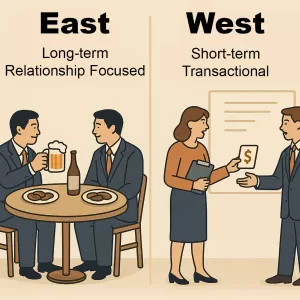No surprise, AI is all the rage these days. The possibilities are endless when it comes to applying AI in sales. Before diving into the ethical considerations, let’s look at some applications of AI in today’s sales landscape.
Content Generation
The ability to quickly produce content has become a game-changer for businesses looking to establish thought leadership and engage prospects. AI-powered content generation tools are helping business owners and sales professionals with content ideation, proofreading/editing, and even drafting.
Text/Copy:
Content generation has advanced beyond simple Q&A – today’s AI can analyze customer data, previous interactions, and industry trends to create highly personalized content that resonates with specific target audiences.
- OpenAI’s GPT models: Capable of generating blog posts, email templates, and sales scripts tailored to specific industries or customer segments.
- Jasper: Specifically designed for marketing content creation, helping nurture leads before they’re ready to be handed off to sales.
- Copy.ai: Specializes in creating various types of sales and marketing copy, from cold outreach emails to product descriptions.
Here are some less obvious prompts/tips to get more out of these AI tools:
- Feed customer data into an AI model and ask it to do predictive modelling for you.
- Feed customer discovery/review data into a model and ask it to perform sentiment analysis or even generate a formal report based on your structure or key points you want it to discuss.
- Train it on your existing content/website so that it understands your brand tone-of-voice and can better produce content that is values-aligned.
- Ask it to provide a comparison between 2 things and output the differences in a table or chart.
Audio:
Great for creating more engaging content + learning & development.
- Google’s NotebookLM: Feed it sources (websites, YouTube videos, or copy-paste content) and it can generate a highly realistic podcast-style discussion of the content. Use prompts to have it analyze things from a specific angle or even debate the topic.
- ElevenLabs: Text-to-speech/voice changing AI. One of the most human sounding text-to-speech tool in the market, available in multiple languages and accents. Even capable of voice-cloning you if you provide it with audio to learn from.
- OpenAI Whisper, Otter.ai, and many others: For audio-to-text transcriptions.
Images:
Used for data visualization, generating complimentary visuals for text-based content, and even creating infographics. Get creative, think beyond Ghibli-fying your images. AI image generation of today is capable of so much more.
- SellerPic: Transforms single product images into multiple sales-boosting assets, including professional-grade product photos with refined backgrounds that captivate customers.
- Midjourney: Creates stunning visuals to complement social posts and capture attention in crowded feeds.
- Canva’s AI features: Helps sales professionals design infographics and visual content that explain complex product benefits simply.
Here are some less obvious prompts/tips to get more out of these AI tools:
- Sketch out an image, upload that into a tool, and ask it to generate a better image based on your instructions. I can’t find the original post, but this image below was generated from someone sketching out in stickman figure style, telling ChatGPT who the characters are, what drawing style, and what they’re saying.

- I generated this image for my other post on Eastern vs. Western Cultural Differences in Business & Sales using ChatGPT. This was the prompt: Can you create an illustration depicted this Eastern vs. Western difference in business/sales? Emphasizing the long-term/relationship building focus for eastern and short-term/transactional focus for western.

- AI can even generate text-heavy images like these without typos now. The more specific you are, the better the output – e.g. create a 4 panel cartoon on How to Pretend to be British, include a point about the accent, drinking tea, and common british lingo like rubbish = trash, truck = lorry, etc.

Video:
- HeyGen & Synthesia: Are the current two with the best lip syncing ability. Not only can you use templated AI avatars to deliver your message for you, you can even generate an AI clone of yourself by training it with a video of yourself.
- Runway: For generating videos from text/images or even expanding on existing videos.
AI Notetaking & Proposal Generation
AI Notetakers are also often underutilized, most are just used for summarizing meetings or taking minutes. Pair an AI notetaker and ask it to output a proposal based on a pre-defined structure and set of criteria.
- Mem.ai: An AI-powered note-taking app that helps entrepreneurs organize research and create professional-looking proposals. Its Collections feature makes it simple to categorize and tag notes, ensuring relevant information is easily accessible when creating proposals.
- Otter.ai: Transcribes meetings and generates summaries with action items.
- Fireflies.ai: Captures meeting insights and can help transform key points into proposal elements.
- Proposal Builder by Insightful Innovation: Will interview you and assist with creating the right proposal.
Customer Service
Gone are the days of unhelpful and frustrating chatbots. Current AI tools are capable of being trained on your website, Standard Operating Procedures (SOPs), and Frequently Asked Questions (FAQs) to give relevant and appropriate information. Whilst most aren’t capable of making independent decisions like waiving certain fees for customers, the improvements in humanization do help with greatly reducing customer frustration whilst assisting them with repetitive FAQs. Bespoke situations can and should still be escalated to a human representative.
- Intercom’s Resolution Bot: Resolves common customer inquiries and can escalate complex issues to human agents.
- Zendesk Answer Bot: Provides instant responses to customer questions based on your knowledge base.
These tools are designed to complement human interaction rather than replace it. The goal is to put customer needs and values at the center of your AI strategy, NOT to use AI to reduce expenses, at all cost.
List Building/Prospecting/Lead Scoring
AI has revolutionized how sales teams identify, qualify, and prioritize prospects, making the process more efficient and targeted.
- Phantom Buster: Automates data collection from various platforms to build prospect lists.
- HubSpot’s AI-powered Breeze Prospecting Agent: Automates sales prospecting by researching contacts in your CRM and executing personalized outreach strategies.
- LinkedIn Sales Navigator with AI features: Helps identify the most promising prospects based on engagement patterns and company signals.
Sales Forecasting
Predictive analytics powered by AI help sales leaders & managers move beyond gut feelings and historical data alone, incorporating a wide range of signals to provide more reliable predictions of future performance which help inform better strategic decisions.
- Salesforce Einstein: Uses AI to predict which deals are most likely to close and when.
- Clari: Provides AI-driven forecasting and pipeline analysis to improve prediction accuracy.
- InsightSquared: Offers detailed forecasting and pipeline analytics for more reliable projections.
E-commerce Product Visualization
E-commerce businesses can also leverage AI to better showcase their products and create immersive visual experiences that help customers better visualize products before purchasing. This improves conversion, reduces return rates and increases customer satisfaction.
- IKEA Place: Uses AR and AI to help customers visualize furniture in their homes.
Is it ethical to use AI in sales?
The answer to the big question isn’t a simple yes or no. It depends on how these tools are implemented and the principles guiding their use. Here are some of my guidelines and recommendations to explore the use of AI ethically.
Transparency is Essential
The foundation of ethical AI use in sales is transparency. Being upfront with customers about when and how AI is being used in your sales process builds trust and respects customer autonomy.
- Clearly disclose when customers are interacting with AI versus human representatives.
- Explain how AI influences recommendations or decisions in the sales process.
- Never try to pass off AI-generated content as human-created without disclosure.
Human oversight is still critical for preventing biases, protecting customer data, and building trust with customers. I like this analogy that Eugen Chen, Chair of the Canadian Open Data Society:
“AI is like a very smart intern, it does a pretty good job but you still need to provide detailed instructions and correct it to produce a good polished output.”
Another critical piece of advice he gave
“AI levels the playing field – if you’re inexperienced at something, AI will make you look good at it. If you’re an expert, the AI output is often below what you’re capable of. To elaborate, if you’re not an artist or graphic designer, AI can produce images way beyond your capabilities. However, if you are one and you use AI without oversight, it’s going to reduce the quality of your output.”
Enabling More Human Connection, Not Less
My personal argument, similar to how you would approach automation, is that it’s entirely ethical, and in-fact, encouraged, to use these tools to enhance human relationships rather than replace them.
- Automate repetitive or tedious tasks to free up time for meaningful customer interactions.
- Use AI to identify when personal outreach would be most valuable.
- Leverage insights from AI to make human conversations more relevant and helpful.
Rather than viewing AI as a replacement for human sales and customer service professionals, treats these tools as augmented intelligence – enhancing human capabilities while preserving the irreplaceable elements of human connection. Just as calculators freed accountants to focus on strategic financial planning rather than manual calculations, AI sales tools give you more time to focus on building genuine connections, complex problem-solving, and creative solutions tailored to unique customer needs.
Data Privacy and Security
Your customer data is the fuel that powers these AI sales tools, making privacy and security non-negotiable ethical requirements. Always ensure you:
- Obtain proper consent for data collection and AI analysis.
- Implement robust security measures to protect customer information.
- Limit data retention to what’s necessary for legitimate business purposes.
Pingback: Advisory Email - Feb - Apr 2025 - ClassyNarwhal